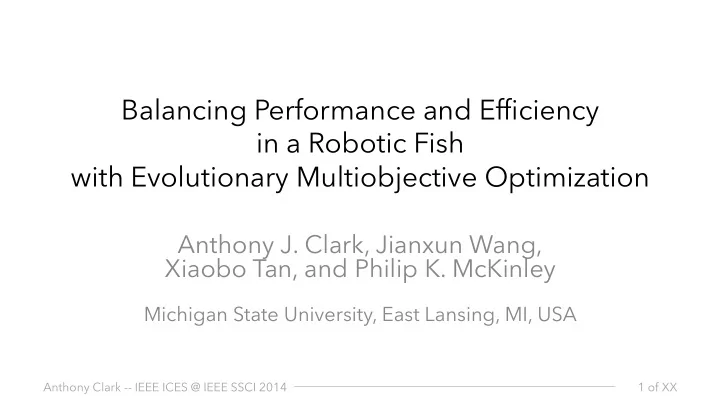

Balancing Performance and Efficiency in a Robotic Fish with Evolutionary Multiobjective Optimization Anthony J. Clark, Jianxun Wang, Xiaobo Tan, and Philip K. McKinley Michigan State University, East Lansing, MI, USA Anthony Clark -- IEEE ICES @ IEEE SSCI 2014 1 of XX
Motivations Optimize Robotic Fish with Flexible Fins Optimize for – performance AND – efficiency While matching flexibility with control settings Anthony Clark -- IEEE ICES @ IEEE SSCI 2014 2 of XX
Robotic Fish Biomimetic Robots Boston Engineering : Robo-Tuna Compared with other aquatic robots – Smaller in size – More maneuverable Actuation – less complex – fewer moving parts Anthony Clark -- IEEE ICES @ IEEE SSCI 2014 3 of XX
Robotic Fish Biomimetic Robots Challenges Complexenvironment Compared with other aquatic robots – turbulence – Smaller in size Flexible components – More maneuverable – changing performance Actuation Limited supervision – less complex – poor communication – fewer moving parts Anthony Clark -- IEEE ICES @ IEEE SSCI 2014 4 of XX
Applications Anthony Clark -- IEEE ICES @ IEEE SSCI 2014 5 of XX
This Paper • Maximize efficiency – focus of several recent studies [Low 2010, Park 2012] – important due to lack of supervision – remain operational as long as possible • Maximize average velocity • Constraints – maximum power exerted by the motor – ratio of length to width for the caudal fin Anthony Clark -- IEEE ICES @ IEEE SSCI 2014 6 of XX
Search Space Pareto-optimal – best solutions Dominated – sub-optimal solutions Infeasible – violate constraints Impossible – unachievable This study: NSGA-II [Deb 2000] Anthony Clark -- IEEE ICES @ IEEE SSCI 2014 7 of XX
Computational Evolution Fin characteristics • – flexibility – length length' – height width' Control parameters • – sinusoidal amplitude – sinusoidal frequency Why evolutionary multiobjective optimization? • – fewer evaluations and more effective than parameter sweep – avoid local optima Anthony Clark -- IEEE ICES @ IEEE SSCI 2014 8 of XX
Flexible Fins Anthony Clark -- IEEE ICES @ IEEE SSCI 2014 9 of XX
3D Printing Composite Fins Anthony Clark -- IEEE ICES @ IEEE SSCI 2014 10 of XX
Anthony Clark -- IEEE ICES @ IEEE SSCI 2014 11 of XX
Anthony Clark -- IEEE ICES @ IEEE SSCI 2014 12 of XX
Efficient Simulation MATLAB / Simulink Hydrodynamics developed by Wang et al. [Wang – 2012, Clark 2012] faster and less accurate compared – to CFD Flexibility rigid bodies – torsion springs (can be converted – to Young’s modulus values) Anthony Clark -- IEEE ICES @ IEEE SSCI 2014 13 of XX
Evolutionary Optimization Task : quick and efficiently forward swimming Evolve • fin flexibility – fin dimensions – sinusoidal control parameters – NSGA-II parameters • 200 individuals in the population – 500 generations for convergence – 20 replicate experiments – Anthony Clark -- IEEE ICES @ IEEE SSCI 2014 14 of XX
Final Combined Pareto-Front • Efficiency – 35 to 40 percent – similar to values found in other studies • Velocity – 4.8 to 5.8 cm/s Anthony Clark -- IEEE ICES @ IEEE SSCI 2014 15 of XX
Caudal Fin Length Anthony Clark -- IEEE ICES @ IEEE SSCI 2014 16 of XX
Discussion Guidelines 1. Flexible fins are more efficient 2. Length-height ratio of 3-to-1 3. Fin length ½ the length of the body 4. Increase speed by increasing amplitude Choosing a single Pareto-optimal value is specific to the task given to the robotic fish. – example : robotic fish needs to operate for 1 hour – choose the fastest solution that is within the bounds for efficiency Anthony Clark -- IEEE ICES @ IEEE SSCI 2014 17 of XX
Physical Trials Anthony Clark -- IEEE ICES @ IEEE SSCI 2014 18 of XX
Physical Results Reality gap – different dynamics – printing fins – noisier control Pareto-front clustering – all are good solutions – tight clustering between solutions Anthony Clark -- IEEE ICES @ IEEE SSCI 2014 19 of XX
Summary In this study we, – optimized a robotic fish for two objectives • objectives: speed and efficiency • evolved parameters: fin morphology and control – we found a set of guidelines for designing robotic fish of similar builds – however, physical results are somewhat inconclusive and will need to be expanded Anthony Clark -- IEEE ICES @ IEEE SSCI 2014 20 of XX
Ongoing Research How can we improve the transferability of evolved individuals? – cross the reality gap through adaptive control How can we get better generality during evolution? – operate under different control conditions – more complex tasks How advantageous are more complex fins? – include non-rectangular fins – include non-uniform flexibility fins Anthony Clark -- IEEE ICES @ IEEE SSCI 2014 21 of XX
Thank You The authors gratefully acknowledge the contributions and feedback on the work provided by: – Jared Moore and – the BEACON Center at Michigan State University. This work was supported in part by National Science Foundation grants IIS-1319602, CCF-1331852, CNS- 1059373, CNS-0915855, and DBI-0939454, and by a grant from Michigan State University. Anthony Clark -- IEEE ICES @ IEEE SSCI 2014 22 of XX
References [Wang 2012] : Dynamic modeling of robotic fish with a flexible caudal fin. In'Proceedings'of'the'ASME'2012'5th'Annual'Dynamic'Systems'and'Control'Conference,'joint'with'the'JSME'2012'11th' • MoCon'and'VibraCon'Conference,'Ft.'Lauderdale,'Florida,'USA,'October'2012. [Clark 2012] : Evolutionary design and experimental validation of a flexible caudal fin for robotic fish. In'Proceedings'of'the'Thirteenth'InternaConal'Conference'on'the'Synthesis'and'SimulaCon'of'Living'Systems,'pages'325– • 332,'East'Lansing,'Michigan,'USA,'July'2012. [Low 2010] : Parametric study of the swimming perfor- mance of a fish robot propelled by a flexible caudal fin. BioinspiraCon'&'BiomimeCcs,'vol.'5,'no.'4,'2010. • Park [2012] : Kinematic condition for maximizing the thrust of a robotic fish using a compliant caudal fin. IEEE'TransacCons'on'RoboCcs,'vol.'28,'pp.'1216–1227,'2012.' • Anthony Clark -- IEEE ICES @ IEEE SSCI 2014 23 of XX
Recommend
More recommend